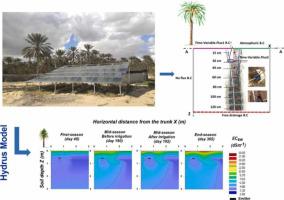Agriculture, Ecosystems & Environment ( IF 6.0 ) Pub Date : 2021-11-19 , DOI: 10.1016/j.agee.2021.107772 Nessrine Zemni 1, 2 , Fairouz Slama 2 , Fethi Bouksila 1 , Rachida Bouhlila 2

|
Irrigation in traditional oases in the Mena region was possible in the past via traditional techniques (foggaras, tabia) and a relative availability of water resources. To promote the development of sustainable oases, in the context of global changes and water resources scarcity and degradation, an assessment of an innovative subsurface irrigation system (Chahbani) was conducted in Saharan Jemna oasis (South of Tunisia). Irrigation water salinity (ECw) was classified brackish (ECw ranged between 3.2 dSm-1 and 4.5 dSm-1). Field investigations were conducted during two crop years (2018, 2019) for palm trees. Capacitance sensors (Decagon 5TE) were installed at six soil depths (0.15 m, 0.40 m, 0.60 m, 0.80, 1 m and 1.20 m) for real time monitoring of soil water moisture (θ) and pore electrical conductivity (ECp). A numerical model (HYDRUS (2D/3D)) was calibrated then applied to investigate the effect of different filed irrigation amounts ((T1F (73% crop evapotranspiration (ETc); T2F (120% ETc)) and different buried diffuser optimization (opt) positions from the trunk of the palm tree (X) and soil depths (Z): (T1opt (X = 1.5 m and Z = 0.3 m); T2Opt (X = 0.5 m and Z = 0.3 m); T3opt (X = 1.5 m and Z = 0.6 m); T4opt (X = 0.5 m and Z = 0.6 m)) on root water uptake, yield production and soil salinity distribution. Simulation results for both field treatments T1F and T2F showed that the amount of root water uptake was always lower than 100%(ETc) with observed yield equal to 45% and 50% for T1F and T2F, respectively. According to buried diffuser position scenarios, installation of the buried diffuser at the canopy of the date palm T1opt (X = 1.5 m) as used in Jemna oasis, showed the least calculated relative yield (37%). However, for lateral distance, X = 0.5 m, root water uptake was equal to 649 mm for T2Opt (Z = 0.3 m) and 855 mm for T4Opt (Z = 0.6 m) with relative yield equal to 54% and 71%, respectively. According to simulation results, all position scenarios showed salt accumulation on the top soil layers and leaching requirement fraction (LR) application failed to decrease salinity for 0–0.4 m soil depth. Supplemental leaching using surface irrigation is thus recommended. Further studies for irrigation with buried diffuser under arid climate and brackish water need to focus on its impact on oasis sustainability especially when used for traditional oases as irrigation system.
中文翻译:

模拟和监测撒哈拉杰姆纳绿洲(北非)枣椰树埋地扩散灌溉下的水流、盐度分布和产量
过去,通过传统技术(foggaras、tabia)和相对可用的水资源,在中东和北非地区的传统绿洲中进行灌溉是可能的。为了促进可持续绿洲的发展,在全球变化和水资源稀缺和退化的背景下,在撒哈拉杰姆纳绿洲(突尼斯南部)对创新的地下灌溉系统 (Chahbani) 进行了评估。灌溉水盐度 (ECw) 被归类为微咸水(ECw 介于 3.2 dSm -1和 4.5 dSm -1 之间))。在两个作物年度(2018 年、2019 年)期间对棕榈树进行了实地调查。电容传感器(Decagon 5TE)安装在六个土壤深度(0.15 m、0.40 m、0.60 m、0.80、1 m和1.20 m),用于实时监测土壤水分(θ)和孔隙电导率(ECp)。数值模型 (HYDRUS (2D/3D)) 被校准,然后应用于研究不同灌水量 ((T1 F (73% 作物蒸发蒸腾量 (ET c ); T2 F (120% ET c )) 和不同埋地灌溉量的影响来自棕榈树树干 (X) 和土壤深度 (Z) 的扩散器优化 (opt) 位置:(T1 opt(X = 1.5 m 和 Z = 0.3 m);T2 Opt(X = 0.5 m 和 Z = 0.3 m) ); T3选择(X = 1.5 m 和 Z = 0.6 m);T4 opt(X = 0.5 m 和 Z = 0.6 m))对根系吸水量、产量和土壤盐分分布的影响。田间处理 T1 F和 T2 F 的模拟结果表明,根吸水量始终低于 100% (ETc),观察到的 T1 F和 T2 F产量分别为 45% 和 50% 。根据埋入式扩散器的位置方案,在 Jemna 绿洲中使用的枣椰树 T1 opt (X = 1.5 m)的树冠上安装埋入式扩散器显示出最少的计算相对产量 (37%)。然而,对于横向距离,X = 0.5 m,T2 Opt(Z = 0.3 m)的根部吸水量等于 649 mm,T4 为 855 mmOpt (Z = 0.6 m) 的相对产率分别等于 54% 和 71%。根据模拟结果,所有位置场景都显示盐分在表层土层积累,淋溶要求分数 (LR) 应用未能降低 0-0.4 m 土壤深度的盐度。因此建议使用表面灌溉进行补充浸出。在干旱气候和微咸水条件下使用埋入式扩散器进行灌溉的进一步研究需要关注其对绿洲可持续性的影响,尤其是当用于传统绿洲作为灌溉系统时。











































 京公网安备 11010802027423号
京公网安备 11010802027423号